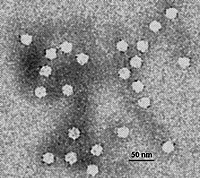
Photo from wikipedia
Introduction Apolipoprotein-A1 (Apo-A1) acts as a negative acute phase protein (APP) during inflammatory states, and has a potential prognostic value in people and dogs with sepsis. The aim of this… Click to show full abstract
Introduction Apolipoprotein-A1 (Apo-A1) acts as a negative acute phase protein (APP) during inflammatory states, and has a potential prognostic value in people and dogs with sepsis. The aim of this retrospective study was to investigate the association of serum Apo-A1 concentration with disease severity, multiorgan dysfunction syndrome (MODS) and outcome in a population of dogs with sepsis, and to assess its correlation with major canine APPs. Methods Ninety-nine dogs with uncomplicated sepsis (n = 78) or septic shock (n = 21) were included. The serum concentration of Apo-A1, C-reactive protein (CRP) and serum amyloid A (SAA) were recorded, alongside the canine acute patient physiologic and laboratory evaluation fast (APPLEfast) score and the presence of MODS. Results Dogs with septic shock had significantly lower serum Apo-A1 concentrations (106.3 ± 22.7 mg/dl; reference interval: 123.0–142.3 mg/dl), higher APPLEfast score (30, 13–38) and greater frequency of MODS (67%) compared to those with uncomplicated sepsis (117.9 ± 19.3 mg/dl; 25, 6–33 and 8%, respectively) (P = 0.0201; P = 0.0005; P < 0.0001, respectively). Similarly, dogs with MODS had significantly lower serum Apo-A1 concentrations (104.1 ± 4.6 mg/dl) and higher APPLEfast score values (31, 13–38) compared to those without MODS (118.32 ± 2.1 mg/dl and 26, 6–33, respectively) (P = 0.0050 and P = 0.0038, respectively). Conversely, neither CRP nor SAA were different between these groups. No difference in serum APPs concentrations was detected between survivors and non-survivors. Significant negative correlations were detected between serum Apo-A1 and SAA (P = 0.0056, r = −0.277), and between serum Apo-A1 and the APPLEfast score (P = 0.0027, r = −0.3). In this population, higher values of the APPLEfast score and the presence of MODS were independently associated with a higher risk of death. Discussion Our study shows that Apo-A1 is a useful biomarker of sepsis severity in dogs, since it is decreased in those with septic shock and MODS. Further prospective investigations are deemed to evaluate the applicability of Apo-A1 to predict sepsis course and response to treatment in septic dogs.
Journal Title: Frontiers in Veterinary Science
Year Published: 2023
Link to full text (if available)
Share on Social Media: Sign Up to like & get
recommendations!